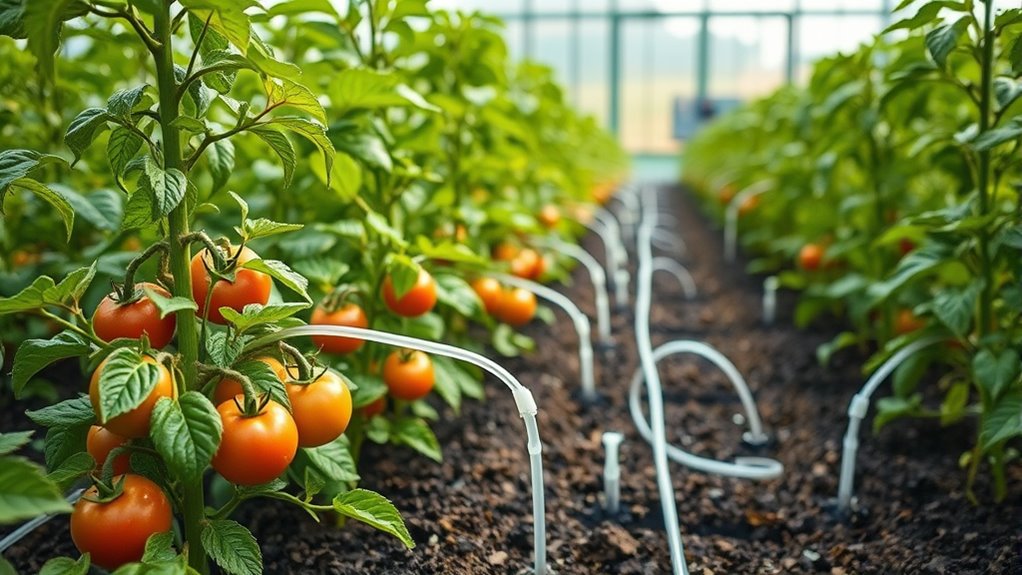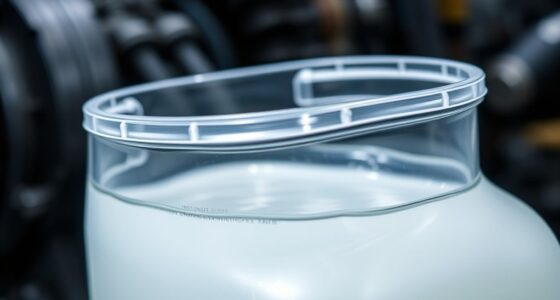To optimize your fertigation system, focus on proper design, sizing, and regular maintenance of equipment. Accurately preparing nutrient solutions and adjusting based on soil and plant needs guarantees healthy growth. Use efficient water delivery methods like drip systems and regularly calibrate sensors for precise monitoring. Keep detailed records of application rates and system performance, and stay vigilant with inspections. Mastering these practices will help you achieve consistent, sustainable results—continue to explore how these strategies come together for success.
Key Takeaways
- Properly size and design systems to ensure flexibility, efficiency, and cost-effectiveness, preventing nutrient under- or over-application.
- Regularly calibrate sensors, flow meters, and dosing pumps for accurate nutrient delivery and system reliability.
- Use precise measurement techniques and efficient delivery methods like drip irrigation, integrating organic fertilizers when appropriate.
- Maintain detailed records of nutrient application, crop responses, and system performance to optimize operations continuously.
- Conduct routine inspections and preventive maintenance to identify issues early, ensuring system longevity and environmental safety.
Proper Sizing and Design of Fertigation Equipment

Proper sizing and design of fertigation equipment are essential to guarantee efficient and uniform delivery of nutrients to your crops. When selecting equipment, consider system scalability; your setup should accommodate current needs and future expansion without requiring complete overhauls. Proper sizing ensures your system can handle water flow and nutrient volumes, preventing under- or over-application. Conduct a thorough cost analysis to weigh initial investment against long-term benefits, ensuring your system remains cost-effective. Well-designed equipment minimizes waste, reduces maintenance, and improves nutrient use efficiency. Avoid undersizing, which can limit productivity, or oversizing, which increases unnecessary costs. Additionally, understanding vibrational energy principles can help optimize system operation and improve overall efficiency. Incorporating precision engineering techniques into your fertigation system design can further enhance performance and reliability, especially by aligning with technological advancements in irrigation technology.
Accurate Nutrient Mixing and Solution Preparation

You need to measure nutrients carefully to guarantee your plants get the right balance. Using precise techniques helps you mix solutions consistently every time. Regular testing confirms your solution’s accuracy and keeps your system running smoothly. Accurate nutrient measurement is essential for optimal plant health and system efficiency. Incorporating technological tools can further enhance the precision and ease of your fertigation practices. Implementing security measures can also protect your equipment and investments from theft or vandalism.
Precise Measurement Techniques
Have you ever wondered how precise nutrient mixing impacts plant growth? Accurate measurement techniques are essential for ideal fertigation. Proper sensor placement ensures you get reliable data, allowing you to monitor nutrient levels and solution concentrations effectively. Position sensors at key points in your system, such as inflow and outflow lines, to capture real-time information. This data logging helps you track changes over time, identify inconsistencies, and adjust your mixing process accordingly. Consistent measurements prevent over- or under-fertilization, reducing waste and promoting healthier plants. By integrating precise measurement tools and maintaining proper sensor placement, you ensure your fertigation system delivers accurate nutrient solutions consistently, ultimately supporting vigorous plant growth and maximizing yields. Regular maintenance of sensors and calibration further enhances measurement accuracy, while understanding industry trends can help optimize your setup. Additionally, awareness of data privacy challenges in automation can inform the secure handling of your system data.
Consistent Solution Testing
How can consistent solution testing enhance the effectiveness of your fertigation system? Regular testing guarantees your nutrient mixing and solution preparation remain accurate, preventing deficiencies or excesses. Using sensor integration allows you to monitor parameters like pH, EC, and nutrient concentrations in real-time. Automation controls help maintain precise solution composition by adjusting nutrient levels automatically based on sensor feedback. This consistency leads to healthier plants, optimized growth, and minimized waste. By regularly verifying the accuracy of your mixing process, you reduce errors that could compromise crop yields. Incorporating sensor technology and automation controls streamlines testing, ensuring your fertigation system stays reliable and efficient. Additionally, understanding CBD’s antioxidant qualities can support overall plant health and resilience. Implementing solution testing protocols ensures consistent nutrient delivery and optimal crop performance. Consistent solution testing ultimately maximizes resource use, reduces costs, and promotes uniform crop development, especially when integrated with AI-driven solutions to further optimize your system.
Regular System Maintenance and Calibration

You need to perform routine inspections to catch potential issues early and keep your fertigation system running smoothly. Accurate calibration techniques guarantee your nutrient delivery remains precise and effective. Regular maintenance and calibration are essential to prevent errors and maintain ideal plant growth. Incorporating proper filtration methods can further improve system performance and protect against contaminants. Additionally, adopting security measures can help safeguard your system from cybersecurity threats that could disrupt operations. Monitoring system performance regularly allows for timely adjustments and ensures consistent nutrient application.
Routine Inspection Protocols
Regular system maintenance and calibration are essential to guarantee fertigation systems operate accurately and efficiently. During routine inspections, you should check for leaks, clogs, and ensure sensors are properly calibrated for precise nutrient delivery. Proper sensor calibration helps avoid over- or under-fertilization, saving resources and improving crop health. Additionally, inspect for pest presence, as pests can damage equipment or contaminate solutions, affecting system performance. Use the following table to guide your inspection focus:
| Inspection Area | Key Actions |
|---|---|
| Sensors | Calibrate sensors regularly, check accuracy |
| Pest Control | Look for pests and take preventive steps |
| System Components | Inspect for leaks, clogs, and wear |
Consistent inspections help catch issues early, guaranteeing effective fertigation operation. Regular maintenance also helps address toilet functionality issues, ensuring the system remains operational and reliable. Incorporating preventive maintenance strategies can further extend the lifespan of system components and reduce unexpected downtime. Being aware of the symptoms of equipment failure can help identify potential problems before they escalate, maintaining system integrity.
Accurate Calibration Techniques
Maintaining accurate calibration of sensors and system components guarantees fertigation delivers nutrients precisely where and when they’re needed. Regular calibration of pH sensors ensures accurate pH adjustment, preventing nutrient lockout or deficiencies. It’s crucial to verify that flow meters and dosing pumps are calibrated correctly to match the nutrient branding and delivery rates. Consistent calibration reduces errors that can compromise plant health or cause over-fertilization. Always follow manufacturer guidelines and use calibration solutions for pH sensors. Schedule routine checks, especially after system repairs or nutrient changes. Proper calibration not only optimizes nutrient uptake but also extends equipment lifespan and minimizes waste. Incorporating advanced tuning software can further enhance system precision and responsiveness. Regularly inspecting headphone jacks and connectors can prevent connectivity issues that disrupt system operations. Additionally, incorporating inspirational quotes about attention to detail can motivate technicians to prioritize calibration accuracy. Accurate system calibration is a critical step toward efficient, reliable fertigation management in horticultural operations.
Monitoring Soil and Plant Nutrient Needs

Monitoring soil and plant nutrient needs is essential for maximizing fertilization in horticulture. Regular testing helps you assess soil moisture levels, ensuring plants receive adequate water and nutrients without over-application. It also aids in pest control, as healthy, balanced soil reduces pest susceptibility. Use soil tests to identify deficiencies and adjust your fertigation accordingly. Keep an eye on plant vigor and leaf color as indicators of nutrient status. Additionally, understanding filtration systems can help maintain soil health by reducing dust and debris that may affect plant growth. Implementing air purification strategies can improve the overall environment, preventing airborne pollutants from impacting plant health.
Implementing Efficient Water and Nutrient Delivery Methods

To guarantee your plants receive nutrients efficiently, implementing effective water and nutrient delivery methods is key. Drip irrigation offers precise delivery, minimizing waste and ensuring nutrients reach the root zone directly. This system reduces water evaporation and runoff, making it ideal for fertigation. When using organic fertilizers, it’s crucial to choose methods compatible with their slower release and organic nature. Drip systems can be easily adapted to incorporate organic inputs, providing a steady supply without overfeeding. Regularly inspect and maintain your delivery setup to prevent clogs and ensure uniform distribution. By combining drip irrigation with organic fertilizers, you optimize nutrient uptake, conserve water, and promote healthy plant growth. This integrated approach creates a sustainable, efficient fertigation system tailored to your horticultural needs.
Record-Keeping and System Optimization Strategies

Effective record-keeping is essential for optimizing your fertigation system, as it provides the data needed to identify trends, troubleshoot issues, and improve overall efficiency. Focus on maintaining high record keeping accuracy by consistently documenting nutrient application rates, timing, and crop responses. Regularly review this data to spot irregularities or inefficiencies. Implement system optimization techniques, such as adjusting fertilizer doses based on plant needs or environmental conditions, to maximize performance. Use digital tools or spreadsheets to streamline data collection and analysis, ensuring accuracy and easy access. By keeping precise records, you can make informed decisions that enhance system efficiency, reduce waste, and boost crop yields, ultimately creating a more sustainable and productive fertigation process.
Frequently Asked Questions
How Can I Prevent Clogging in Fertigation Nozzles?
To prevent clogging in fertigation nozzles, you should focus on proper filtration techniques, ensuring filters are regularly cleaned and replaced to catch debris before it reaches the nozzles. Additionally, perform routine nozzle maintenance by inspecting and flushing them to remove buildup or blockages. Using high-quality filters and maintaining a consistent maintenance schedule will keep your system running smoothly and prevent costly clogs.
What Are the Signs of Nutrient Imbalance in Plants?
When it comes to nutrient imbalance, signs are your plants’ way of telling you something’s amiss. Watch out for plant deficiency symptoms like stunted growth or irregular leaf discoloration, which can indicate missing or excess nutrients. If leaves turn yellow or exhibit unusual patterns, it’s a clear sign of imbalance. Pay close attention—these clues help you catch issues early before they become a bigger problem.
How Do Weather Conditions Affect Fertigation Schedules?
Weather variability substantially impacts your fertigation schedules because it influences plant nutrient uptake and water needs. During hot, dry weather, you should increase fertigation frequency and volume to prevent deficiencies, while cooler, rainy periods may require seasonal adjustments to avoid over-fertilizing. By closely monitoring weather patterns, you can optimize nutrient delivery, ensuring your plants stay healthy and productive despite changing conditions.
Which Sensors Are Best for Real-Time System Monitoring?
Imagine balancing precision like a tightrope walk. You need reliable sensors that deliver real-time data, such as EC, pH, and moisture sensors, which are vital for effective fertigation. Prioritize sensors that are easy to calibrate and integrate seamlessly with your system, ensuring accurate readings. Regular sensor calibration and robust data integration help you make informed decisions quickly, optimizing nutrient delivery and crop health.
How Often Should I Update My Fertigation System Components?
You should update your fertigation system components regularly to maintain efficiency. Typically, perform system calibration and check sensors monthly, and replace components like filters or pumps annually or when they show signs of wear. Keep an eye on performance indicators, and don’t delay component replacement to avoid system failures. Regular updates ensure your system stays accurate, dependable, and ideally delivers nutrients to your plants.
Conclusion
By properly sizing and maintaining your fertigation system, you guarantee healthy plant growth and maximize yields. But neglecting these practices can lead to wasted resources and poor crop quality. It’s the difference between a thriving garden and one struggling for nutrients. When you balance precise nutrient mixing with vigilant system calibration, you create a reliable, efficient setup. In horticulture, success isn’t just about technology—it’s about your commitment to best practices that make all the difference.









